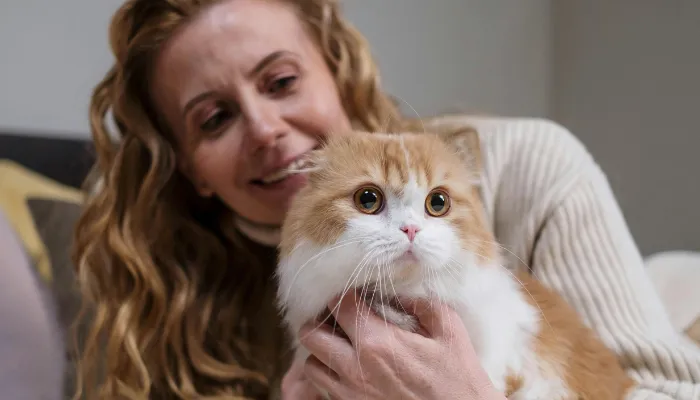Every cat is unique and possesses a distinct personality. Most cats are solitary and enigmatic. How do cats say “I hate you”? They do not engage in verbal communication, but their actions, intentions, and speech can tell you a great deal about how they feel. They might not necessarily hate you, but instead be showing ear, pain, or anxiety.
If your pet pal is keeping away from you, hissing, or more boldly, ignoring you entirely, it is probably best to try and decode what it is feeling. Perhaps a Cat Translator would ease things, but these emotions can show themselves in simpler, more natural ways.

Signs That Your Cat Might Dislike You
Not all cats are affectionate, but certain behaviors may indicate they are not happy with you. Here are some clear signs:
1. Tail Position
A cat’s tail alone can tell a lot about how it feels. Few things to watch out for include:
- Puffed-up tail – Indicates fear or aggression.
- Thrashing tail – A sign of irritation or anger.
- Tightly wrapped tail – Shows discomfort or stress.
2. Hissing and Growling
Cats only growl when they feel threatened. Constantly growling or hissing cats are uncomfortable and unhappy.
3. Avoiding You
If your cat runs away when you approach or hides under furniture, it may not enjoy your company. How do cats say “I hate you”? Avoidance is one of the strongest indicators.
4. Flattened Ears
When a cat’s ears are pinned back, it is feeling defensive or aggressive. This is a warning sign to give it space.
5. Scratching and Biting
Cats that bite or scratch at their owners are not displaying playfulness, but rather expressing their discomfort. Aggressive biting and swiping don’t equal play.
Understanding these signs can help improve your bond and make your cat feel more comfortable.
Comparing Friendly vs. Aggressive Cat Behavior
Recognizing the difference between friendly and aggressive cat behavior helps in understanding your feline’s mood. How do cats say “I hate you”? Small details like tail position, eye contact, and sounds reveal whether your cat feels comfortable or threatened.
| Behavior | Friendly Cat | Unhappy Cat |
|---|---|---|
| Tail Position | Upright, relaxed | Puffed up, thrashing |
| Eye Contact | Slow blinking | Dilated pupils, direct stare |
| Body Language | Approaching, rubbing | Hiding, stiff posture |
| Sounds | Purring, meowing | Hissing, growling |
Noticing these behavioral cues can strengthen your bond and prevent misunderstandings with your cat. A happy cat communicates through relaxed body language and gentle interactions—watch for the signs!
Why Do Cats Act Like They Hate You?
Sometimes, cats exhibit these behaviors not because they dislike you, but due to specific reasons. Here are a few possibilities:
1. Stress and Anxiety
Cats can be sensitive to changes in their environment. If you moved around your furniture or got a new pet or changed your routine, they might have a negative reaction.
2. Lack of Trust
How do cats say “I hate you”? One way is through distrust. If you’ve done something that startled them, they may become wary.
3. Overstimulation
Some cats enjoy being pet, but too much can make them agitated. Watch for signs like tail flicking or ears flattening.
4. Territorial Behavior
A seemingly out-of-the-blue aggressive cat may be extremely territorial. Aggression can stem from a change in the environment such as an unfamiliar person or animal.
5. Health Issues
Pain or illness can make a cat act out. If their behavior changes suddenly, a vet check-up is recommended.
Understanding these reasons can help improve your relationship and make your cat feel more at ease.
How to Improve Your Relationship with Your Cat?
If your cat is showing signs of dislike, don’t worry. There are ways to build trust and improve your bond.
1. Give Them Space
Let your cat approach you on its terms. Forcing interaction can make things worse.
2. Use Positive Reinforcement
Offer treats or toys when your cat behaves positively. Avoid punishment, as it can damage trust.
3. Learn Their Preferences
Some cats prefer head scratches over belly rubs. Pay attention to what they enjoy.
4. Maintain a Routine
Cats love consistency. Feeding, playtime, and sleeping schedules should remain steady.
5. Speak Their Language
Understanding your cat’s body language can help you respect its boundaries. How do cats say “I hate you”? By recognizing their signals, you can prevent negative interactions.
Building trust and understanding will help turn your cat’s attitude into affection over time.
10 Common Questions About Cat Behavior
Understanding your cat’s behavior can be confusing, but these FAQs address common concerns and solutions.
Q1. In what ways can people think that cats say “I hate you”?
Through body language, hissing, and avoidance.
Q2. Do cats have the ability to hate their owners?
Not really. Owners will rather experience discomfort.
Q3. Why does my cat tend to run away from me?
It may not feel comfortable with you yet, or feel overstimulated.
Q4. What does aggression or fear tail looks like on cats?
It indicates agression, fear, or aggression.
Q5. Why does my cat dislike me? What is one way I can make them feel better?
Using positive reinforcement and maintaining routine, more importantly, giving it space.
Q6. Why does my cat paw me?
Your cat is annoyed, in pain, or too stimulating.
Q7. Did my cat choose to ignore me?
Certain cats can be more self-sufficient and like alone time.
Q8. What are some unique ways cats apologize?
They tend to do so by slow blinking, head rubbing, and bringing small gifts.
Q9. What is the reason for hissing at me?
It feels as though it is threatened or highly uncomfortable.
Q10.What are some reasons a cat says they dislike you?
They flatten their ears, avoid aggressive behavior, or run away.
A better grasp of these answers can help strengthen your bond and improve your cat’s trust in you.
Conclusion
How do cats say “I hate you”? Their body language, sounds, or actions can express discomfort or displeasure. Nevertheless, most cats do not want to hurt their owners; they only wish for space, more trust, or a change of scenery. Understanding signals your cat is sending allows you to be able to connect better and make their lives easier. So make sure to give them some space – and a chance to trust you more.
